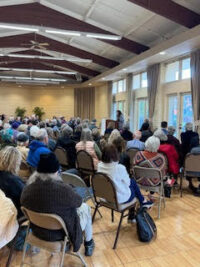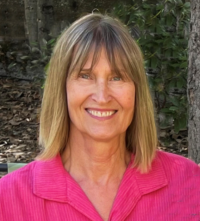Sonoma residents seeking answers turned out in force for Thursday night’s town hall meeting hosted by Sheriff Bill Cogbill and Supervisor Valerie Brown. Approximately 100 local residents went to the Sonoma Valley Grange to discuss a variety of topics, among them sexual assault, gang activity and deputy-involved shootings.
The meeting, conducted in a very controlled setting, began promptly at 6 p.m. and ran slightly over the originally prescribed two-hour time limit. After introducing the assembled panel, Sheriff Cogbill spoke about crime in general, stating that there has been no dramatic increase nor decrease in the number of incidents in the Sonoma Valley in the past three years. Brown opened by saying she was generally concerned about how budget cuts might compromise public safety. She aired the idea of forming an assessment district in the Springs area to pay for increased law enfocement.
Many audience members wanted to discuss the recent shooting death of Craig Von Dohlen, as well as officer-involved shootings and citizen review committees. Interrupted by a raised hand from the audience, Cogbill was asked for comment on what many believe has been a rash of deputy-involved shootings throughout the county. He said there have only been six of these shootings in the past nine years.
Cogbill said he couldn’t comment on the Von Dohlen case as it is still under investigation, but went into a lengthy explanation of the protocol involved. He said that the Santa Rosa Police Department is handling the investigation and that all cases automatically go to a court-appointed grand jury for review. He argued that this serves as a sort of citizen review, which didn’t convince all community members present.
Cogbill and Brown also criticized budget cuts to mental health services and drew attention to the impact of methamphetamine use.
“What’s been a huge factor in deputy-involved shootings has been not just mental health, but drugs as well,” said Cogbill. “When mental health services were cut back years ago, I predicted that law enforcement would be left to deal with it. A large percentage of inmates in jail have mental health issues. They shouldn’t be there – they should be getting treatment. We have to find a way to help these people.”
Around 7 p.m., the meeting was opened up to questions from the audience, which they submitted on note cards. Many questions on how law enforcement responds to calls involving the mentally ill.
Cogbill said that officers receive 24 hours of training on how to respond to calls involving the mentally ill. However, he said studies show that, regardless of training, if a community service system for the mentally ill isn’t in place or is falling apart, law enforcement will have a tough time handling it alone.
Community member Elena Alioto interrupted the reading of questions, standing up and tearfully asking Cogbill and the other panel members how many people had to die in our community before something was done. She brought up the issue of police accountability that had been echoed by many other members of the audience. Both Cogbill and Brown said problem is not having enough mental health resources available.
Valerie Brown said she was putting drug and alcohol treatment programs and mental health treatment under the same umbrella. According to her, Prop. 63, which was supposed to create funding for mental health programs, actually did just the opposite.
“The way it was written, it seemed like it was going to help people,” said Brown. “In reality, all of the funding goes to new programs. Existing and/or under-funded programs got nothing. And now, with reduced revenues, we’re going to have to look at new ways to deliver services.”
Brown said that methamphetamine use has caused problems ranging from increased crime to chemical clean-up that cost the county $12 million a year. “We’d like to have that money to use for treatment and prevention rather than spending it on things like lab clean-up,” said Brown.
Cogbill also talked about Sonoma’s gang situation. He said that gangs have been an issue in Sonoma for decades, but most residents didn’t realize that until17-year-old Luis Miranda was shot to death in Maxwell Park in October 2007. It was the first gang-related murder in the Valley.
Sonoma, traditionally Sureño gang territory, has seen an influx of members from the rival Norteño gang in recent years, Cogbill said. As the Norteños have established themselves here, more conflicts have arisen.
“We see gang activity in the community and in the high school and things will go quiet for a while and then we’ll see a resurgence like we did around the anniversary of the shooting,” said Cogbill. “We’re very concerned about any level of gang activity and when there is evidence of a new outbreak we set up a task force to monitor the situation for a few weeks until it is under control. This has been a very effective strategy for us.”
Throughout Sonoma County there are approximately 3,100 known gang members. Here in Sonoma Valley there are an estimated 206. Sonoma Police Chief Brett Sackett has worked with the school board to institute the high school dress code and bring gang awareness to a new level.
“The community has to work with law enforcement on this one to combat the problem,” said Cogbill. “The non-profits like the Valley of the Moon Teen Center and the Boys and Girls Club are great alternatives to gangs. We have to make a stand and keep kids from joining gangs by giving them other things to do. And if they do join a gang, they have to know there are serious consequences for their behavior.”
Another audience member, Dmitra Smith, was called upon to speak about the Springs sexual assault. Smith, a Vallejo Avenue resident, was inside her home watching a movie while the assault happened almost directly across the street from her house.
“It breaks my heart that I was right there and didn’t know anything was happening,” said Smith. She organized a candlelight vigil attended by 200 people and has since worked with county Public Works to get lights installed in five of the darkest areas of the neighborhood. Women in the audience asked how they can protect themselves and their daughters.
“Get a whistle,” said Bobbi Turner of the non-profit United Against Sexual Assault. She showed the audience the whistle on her key chain and said that a rapist will typically flee if the victim calls attention to herself. She also recommended that people always walk with a friend or dog, even during the day.
As the meeting wound down, audience and panel members agreed that this kind of gathering should happen more often. Many, including Brown, expressed their interest in holding a forum focused on mental health issues in the county.
Citizen resource directory
There are people vandalizing the building next door right now.
Sonoma County Sheriff’s Department Dispatch: 707.565.2121
My relative/friend is having a psychotic episode and I don’t know what to do.
Psychiatric Emergency Services: 707.576.8181
Emergency 24-Hour Line: 800.746.8181
I have a complaint about a specific mental health incident and the way the county handled it.
Patient rights advocate Hank Hallowell: 707.565.4978
I was sexually assaulted.
The first thing to do is to file a report with the Sonoma County Sheriff’s Department. Dispatch: 707.565.2121
United Against Sexual Assault of Sonoma County (UASA) runs a 24-hour crisis line and can help you with a wide range of questions: 707.545.7270
Sonoma County Victim Assistance Center can help put you in touch with crisis counseling and emergency services like food, shelter, clothing, medical referrals and transportation: 707.565.8250
My street is really dark and I’d like to see more lighting installed.
Sonoma County Public Works Department: 707.565.2231
The Sonoma Valley Sun is currently putting together a community resource guide of important numbers to call. E-mail your questions and suggestions to news@sonomasun.com.
Watch SVTV 27 Video Report
[flv:http://thmm.com/thmm-ads/ApprovedSierra.flv 400 266]












